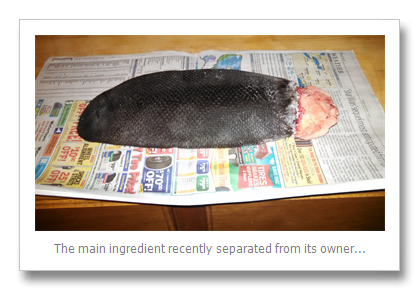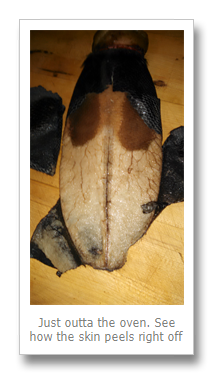Written by
Hunter Grimes posted on January 13, 2015 12:22
When I was a toddler many years ago, there were several thoroughly river rat locals who were known to relish the bounty of The River environs. They must have endured the great depression, but I bet they seldom went hungry. Perhaps with their encouragement and generosity, my Virginia transplant father was introduced to delicacies which seem to get little regard these days. For several years now I have been campaigning to renew appreciation for these delicacies and I am too often not taken seriously.

Many a time I was given a couple quarters and sent to Sid Patterson’s house to “buy” a cardboard box full of muskrat carcasses. It was a hike of over a mile, especially if the ice short-cut wasn’t strong enough to walk on. Standard trapper practice was to hand over the rats minus the fur only. The naked carcasses made the cardboard box soggy and hard to carry. My mother had no problem removing heads, tails and innards and converting the rest to succulent table fare…usually frying them like chicken. Muskrat meat is very healthy and delicious. I have even made a very nice pate’ from their livers.
I am really passionate about this. The lowly muskrat is only one of several overlooked food sources generally abundant in North America. In our St Lawrence River region, thousands of pounds of this meat are discarded every year.
A few days ago I was called by a trapper friend to come over and pick up a beaver tail I had “ordered”. You will note herein a picture of said tail. Admittedly, it does not look very appetizing. Put it on a sheet pan and stick it in a hot oven for about five minutes and watch the scaly looking skin puff up like a football. It will look like it is going to explode but, I have never seen that happen. When cool enough to handle the skin easily peels off from the things within. Notice you are left with a nearly meatless tail. It is not fat, but more like a unique cartilage with bone segments. This goes into a pot with at least a quart of water and is boiled gently until the tailbone segments are easily removed with a fork or slotted spoon. The odd whitish stuff left is a somewhat the same consistency of fish without the flakiness. Dump the contents of the pot into your food processor. With a few good pulses, it will look like a rich cream. You now have a luxurious soup stock unlike any other. Add a few diced carrots and dried green peas and you will end up with pea soup which would be the envy of the finest French chef.
Enough about the soup.
An adult beaver is a big animal, often exceeding forty pounds. Like the muskrat, the beaver eats simple plant life as well as tender bark of birch and aspen. Many of you will have noticed than when pressed with hunger and over population, they will go after your prized oaks, maples, and occasionally your conifers. In any case the meat is clean with fat only on the surface. It can be prepared much like beef. I have fooled picky eaters into thinking a slice off a roasted hind quarter is beef. I think we all know organ meat is high in cholesterol, but liver is rich in good things and there is no liver better than beaver’s ! It can be as big as a small calf liver and is much milder and sweeter than any other. I insist it is as decadently good as foie-gras.

When the price of beaver pelts warrants their harvesting, trappers in northern NY will collectively discard tons of beaver carcasses. This is so sad especially considering the chemical and fat laden stuff that sells in stores for exorbitant prices. I swear some folks would buy cow manure if it was displayed in a little white tray with cellophane stretched over it.
Dear reader, you may still be dubious. Consider this : A few years ago we were invited to an extravagant Christmas party down in Syracuse at a lakeside restaurant reserved for the occasion. Hosted by a very successful business man, there were easily a hundred in attendance. Most were unapologetically affluent and very well attired for the occasion. An avid outdoorsman, the host served professionally prepared fish and game such as pheasant, trout and venison. When inviting me, he requested I bring something from my own supplies to add to his as he did not want to be short of good things to eat. I cut a couple beaver into bite size chunks, marinated them a while and then grilled the pieces on skewers. Of course, just like fine beef or venison it had a nice sear on the outside and was rare inside. The results were carried about amongst the sequined gowns and natty tailored suits by lovely waitresses. To avoid a scene I asked it to remain a mystery meat for a while. The word quickly spread that the pieces of meat with a toothpick handle was delicious. Not long after a ripple of exclamations could be heard over the din of the partiers. Beaver ! Beaver ?? The lot of it was soon gone and there was nary a complaint.
I could wax philosophically about this for hours worth of print. My advice is to befriend a trapper. He is a source of excellent free meat. If you are fearful about preparation, invite me to come and cook for you. Once again our River can provide for you in ways good for your palate as well as your soul. Incidentally, the muskrats from the River environs are generally larger and better eating than the swamp variety.
If you are one of the over zealous versions of the animal rights advocates, take heart. Beavers and muskrats are a naturally renewable resource which is not only sustainable but constitutes a nuisance in many areas. In defense of trappers, please consider that fur is a marvelous, durable material that has covered and adorned hairless humans for eons. If you are a lady who abhors the thought of fur garments you have surely worn another part of the beaver without knowing it for the beaver caster is also saved and sold by smart trappers as it is still the base of many high end perfumes. Now try the soup and enjoy !
By Hunter Grimes III
Hunter Grimes is well known in the region. He is certainly a genuine River Rat – a reliable term given for those who spend their lives on, in or under the River. In 1989, Canadian author Shawn Thompson wrote his book, River Rats: The People of the Thousand Islands; page 68 has the Hunter Grimes story. Hunter and his wife Martha have devoted their lives to their community, both being recognized for their volunteer efforts and leadership.
To see other of Hunter’s essays in TI Life, click here. We especially recommend An Essay: I Hate to Burst your Bubble and the many comments he received.